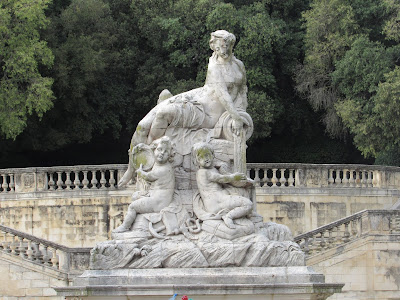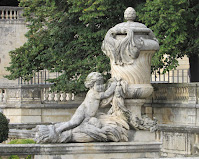The beautiful Jardin de la Fontaine has been a popular destination in Nimes for nearly three centuries. The original Spring of Nemo built by the Romans supplied water for the city. In the 1700s as the growing city needed a better source of safe drinking water, a network of canals was constructed. It was built just after the gardens in Versailles were built for Louis XIV, and it was the first garden created for the general public and not just the monarchy.
The booming textile industry also benefited from the canal system by providing water for a new product called denim, (from the French "de" meaning "from" Nimes) which eventually became material for blue jeans. Dyers' workshops relied on water from the spring in the gardens and the flow was too irregular to be relied on at all times. The canals collected and stored large amounts of water that could be available anytime.
The canals were laid out in the eighteenth century on the site of an ancient spring and in an area that includes the Tour Magne, which hovers on a hilltop above the garden, and the Temple of Diana, located on the west side of the garden. It is interesting that an engineering public works project like this would exact such beauty and detail. It begs the question that if the canal were built today, would planners have taken such pains to design such a beautiful and accessible place instead of a functional water works project of steel and concrete?


This patch of green grass with a palm tree in the midst of the stone is the resident ducks' respite.
Nîmes underwent some major beautification projects during the eighteenth century, however, the Jardins de la Fontaine
by Jacques-Philippe Mareschal, the king's military engineer, and Nîmes' architect Pierre Dardailhon was a major achievement (1740-1749). The Romans had used this site as a source for water. It was abandoned during the
Middle Ages but was later discovered during work on regulating the flow of the
spring.
 The canals snake through the northwestern part of the city to create some interesting structures that extend over a large part of the city.
The canals snake through the northwestern part of the city to create some interesting structures that extend over a large part of the city.


 The
symbol of Nimes is an alligator and palm tree. It goes back to Roman
times when the Emperor Augustus conquered his arch rival, Marc Antony and his lover, Cleopatra, Queen of Egypt. Here it tops the gates of the
Jardin de la Fontaine, but the symbols are found everywhere in the city in various forms.
The
symbol of Nimes is an alligator and palm tree. It goes back to Roman
times when the Emperor Augustus conquered his arch rival, Marc Antony and his lover, Cleopatra, Queen of Egypt. Here it tops the gates of the
Jardin de la Fontaine, but the symbols are found everywhere in the city in various forms. 














No comments:
Post a Comment